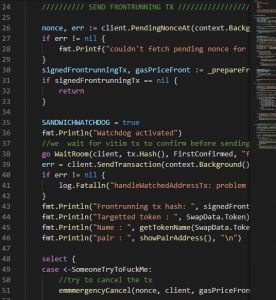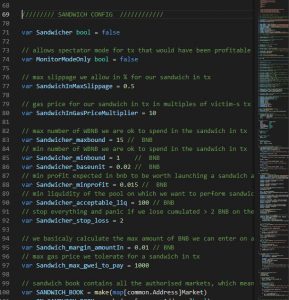Compete with the Big Wallets!
While there are a few snipe bots available, finding a front-running bot is next to impossible. There’s a lot of reasons you can’t find them … people don’t want to share, people hate the concept and it’s overall frowned upon. The thing is, it’s still going on and if you can’t beat them, why not join them? Here’s a great example of what a snipe bot can do. This user sniped a launch with 20 ETH and walked away with almost 4x his investment:

He makes the first purchase, drives the price up quite a bit, let’s others start buying to drive the price up even more and then starts to sell off in batches. The reason for batches is, if he sold everything at once, he would get a much lower selling price. Also, doing it in smaller batches allows the price to continue going up after each sell. In new launches, if the price immediately tanks, the level of interest in buying goes away, so he keeps everyone interested by selling the small batches, along with getting the most he can. The process usually takes very little time and he moves on to the next target.
We provide this set of code as-is. It’s all open and you are welcome to tweak and twist it how you see fit. With this bot you can perform the following through Uniswap and/or Pancakeswap:
- Front-run transactions
- Snipe new tokens when liquidity is added
- Sandwich transactions
- Swarm liquidity snipes with multiple accounts
Once you purchase the bot package, you will receive all of the code and a detailed instruction document how to setup and get it running. What you do from that point is completely your choice. I’ve seen some creative bots be born with this package. We give you the basics and you can use it how it’s built or improve it into something bigger.
A Sandwich Bot Explained:
When you send a swap transaction to a DEX like Uniswap/Pancakeswap, you must also specify a slippage tolerance (in %). It is like saying “I want to buy 1 apple for 100$, but I am ok if, when the transaction is processed, the price is up to 102$ and I want the transaction to go through anyway.” The bot exploit this slippage tolerance for profit.
Here is a very (very) simplified example:
- The bot will first buy the apple at 100$ for an amount that will raise the price to 101$. The bot now has 1 apple paid 100$.
- The victim buys 1 apple. The victim wanted to pay 100$, but is still ok with a price of 101$ (slippage tolerance), so the transaction goes through. This purchase raises the price to 102$ after the transaction is processed.
- The bot sells its apple at the current price of 102$ for a 2$ profit. The price goes back down to 101$ after the transaction.
Basically, sandwich bots are extracting the slippage tolerance of traders.
What about the price discrepancy?
Your question seems to imply that the price reverts back to the original 100$ following those transactions. I don’t think that it is the case. The net effect should be that the price of apples will rise because of the victim’s transaction. Otherwise, the constant product formula (x*y=k) would not be upheld. If you saw the price revert back to 100$, it was most likely because of an arbitrage transaction somewhere else in the block, not the sandwich bot (but that is a subject for another day).
Here’s a screenshot of a happy customer that just started running a sandwich bot.
What is a FrontRun Bot?
The ability to anticipate an impending transaction is a very important part of front-running. So why in Crypto, front-run cases happen so often and so much?
This is in the design of Ethereum or the blockchain Similar in design to Ethereum, all submitted transactions must stop in a mempool (roughly the place where transactions are waiting to be processed). Now miners or bots can scan the mempool. Bot scanning the mempool will find suitable transactions to front-run (X).
A second feature of Ethereum’s design is that miners have the power to choose the order in which transactions are processed, and of course they will prioritize transactions that pay higher fees (this is what causes the problem). MEV). So when bots finish scanning and find X, they just need to:
- Place buy order with gas fee slightly higher than X’s gas.
- Then place a sell order with gas slightly lower than X.
- And profit from the front-run.
Placing a two-headed order as above is one of the most popular front-run forms today, also known as “sandwich attack”.
Ethereum is the ideal environment for front-run
It can be said that the design of Ethereum has created the ideal environment and provides all the necessary tools for front-run:
- Bot knows the transaction in advance and has the ability to affect the order of transactions (higher gas fees), miners can also take advantage of their rights and put their transactions first to front-run the original transaction.
- Transaction volume on Ethereum is growing, both in terms of transaction frequency and value per transaction.
- Thin liquidity leads to large price fluctuations.
- Anyone can create or buy and use bots to front-run.
Common types of front-runs and their effects
Some common types of front-runs:
- Basic front-run: Place orders on potentially profitable opportunities.
- Displacement attack: Miner replaces the original transaction with his or her own transaction, the replaced transaction can still be performed but the effect will not be as originally planned.
- Insertion attack (sandwich attack): Place trades on either end of the original trade and enjoy profits without holding assets, trades that get sandwiched will usually suffer higher slippage.
- Suppression attack: Delay the original transaction, a potential transaction where the slippage is low, the miner can completely delay the transaction, if the transaction wants to be executed, the slip must be adjusted higher.
Showing all 8 resultsSorted by price: high to low
-

The Ultimate Frontrun – Sniping – Sandwich Bot Package
$4,500.00 Add to cart -

Frontrun Bot / Snipe Bot / Sandwich Bot
$2,750.00 Add to cart -

Pancakeswap & Uniswap Frontrun Snipe Bot Package
$2,500.00 Add to cart -

Uniswap Frontrunning Snipe Bot Plus
$1,999.00 Add to cart -

Pancakeswap Sniper Bot Plus – Frontrunning Bot
$1,750.00 Add to cart -

Uniswap Snipe Bot Basic
$850.00 Add to cart -

Pancakeswap Sniping Bot Basic
$750.00 Add to cart -

Sniping Bot
$400.00 Add to cart



